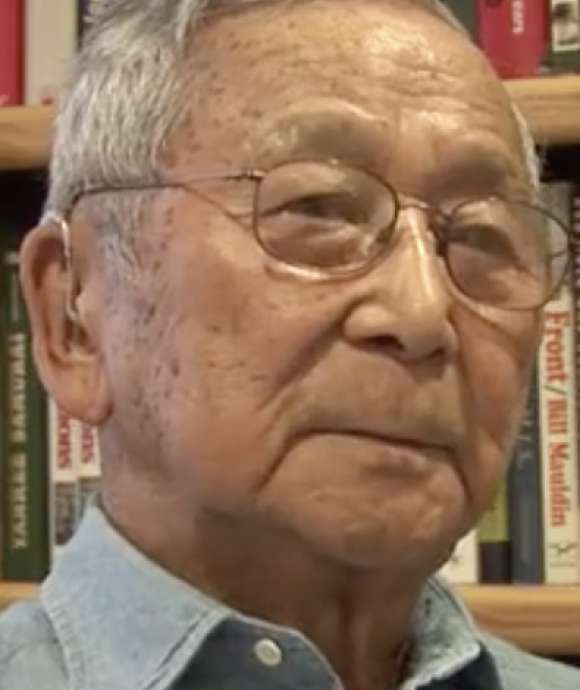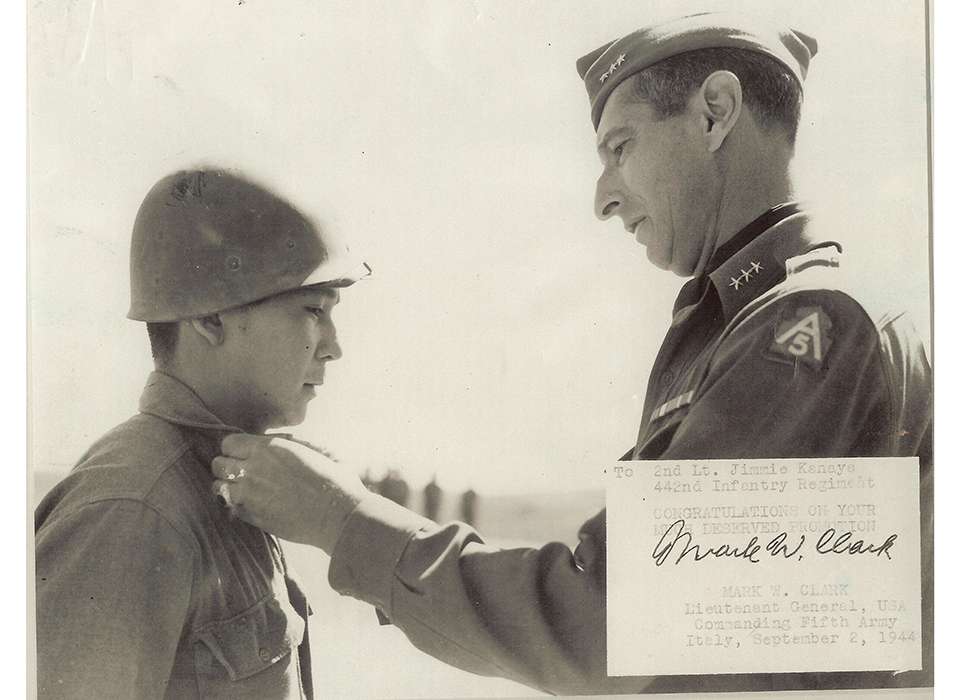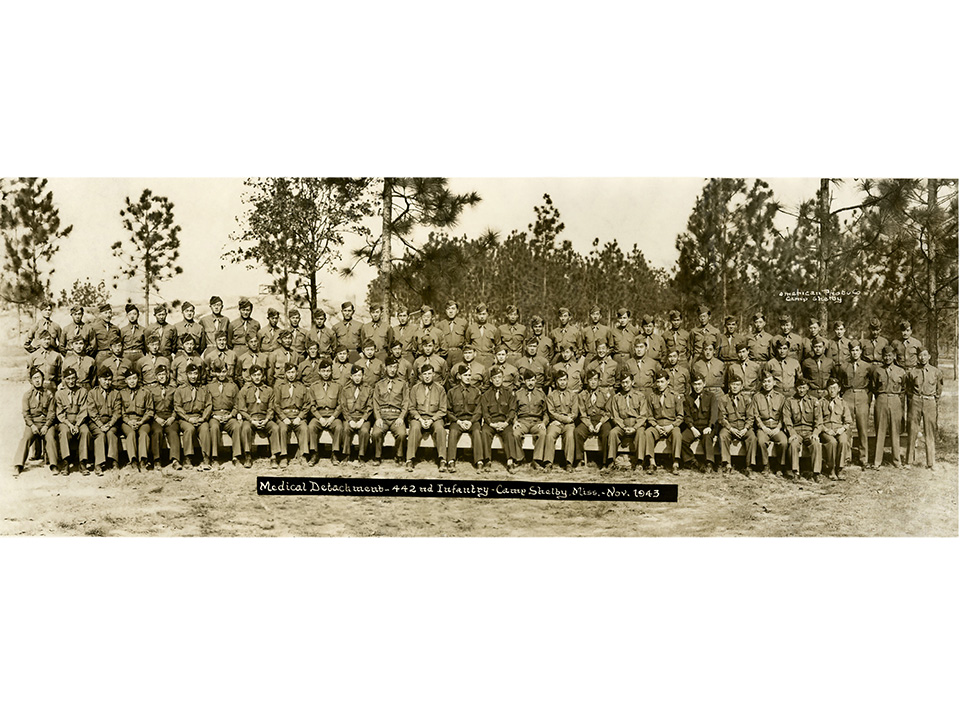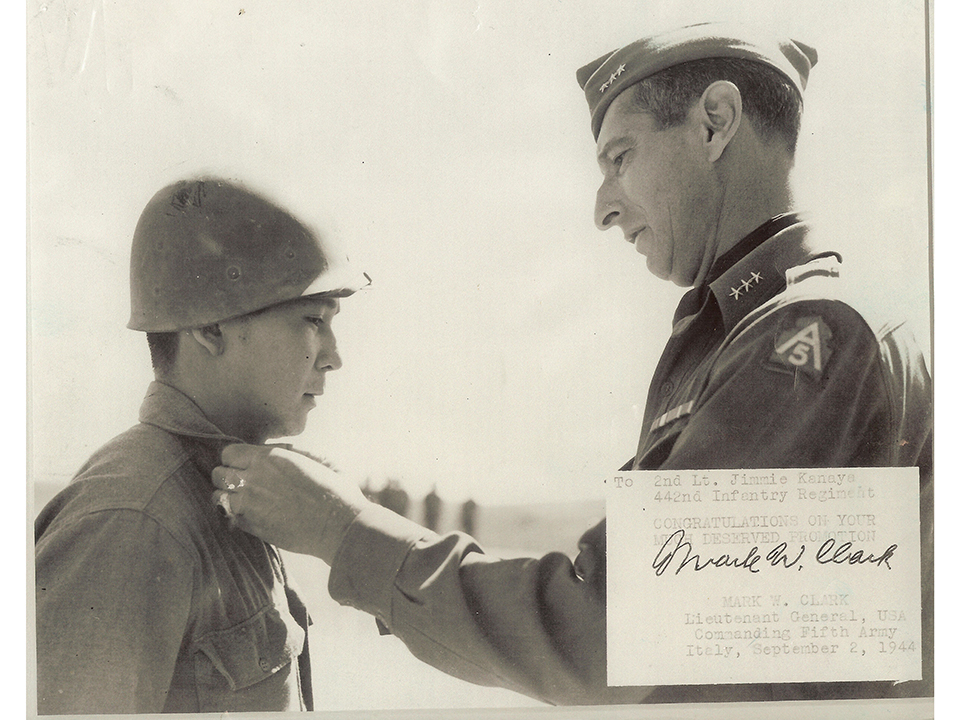Colonel Jimmie Kanaya, 442nd Regimental Combat Team medic, became a prisoner of war in Germany after his family had been put behind barbed wire at home in the States. He went on to be a decorated three-war veteran and friend of The National WWII Museum who passed away November 7, 2019.
Jimmie Kanaya was born in 1920 to Japanese immigrants in Clackamas, Oregon. Growing up, he was fascinated by the military and he enlisted in the Army in April 1941. After the attack on Pearl Harbor, all Japanese Americans were subjected to suspicion and prejudice, even those serving their country in the US military, like Kanaya. Japanese Americans were declared “enemy aliens” and were thus ineligible for service. Those already in service were not considered for combat and were in limbo as the military decided what to do with them. Would they be moved? Would they be discharged? Kanaya was transferred from Hoff General Hospital in Santa Barbara where he was serving as a medic and moved further inland (out of the “Exclusion Zone” from which Japanese Americans were removed according to Executive Order 9066 issued in February 1942). Kanaya was given a short leave to visit his family and help sell their belongings as they were forced from their home and sent to the assembly center in Portland, a round-up point before being sent to the incarceration camp. Kanaya returned to his post at Camp Crowder, where he was promoted to First Sergeant.
Kanaya continued on in service in the Midwest at Camp Crowder and then Ft. Leavenworth, Kansas. It would be several months before he and other Japanese Americans were given the opportunity many had been waiting for, the chance to prove themselves in combat and on the battlefield. In February 1943, the Japanese American unit, the 442nd Regimental Combat Team, was established. Kanaya and other Japanese Americans who had been in the military prior to Pearl Harbor formed the backbone of the newly-formed segregated outfit. The 442 completed intensive infantry training at Camp Shelby, Mississippi, where they joined troops from the extent 100th Infantry Battalion composed of Japanese Americans from Hawaii (who unlike those from the mainland US were a significant portion of the population and were not sent to camps).
Before Kanaya was shipped to serve overseas with the 442, he was able to visit his parents twice at Minidoka War Relocation Center in Idaho. Walking through the camp in his Army uniform, he felt like a complete outsider. Minidoka was no home to visit on leave, no home-cooked food or other comforts of home, no homecoming parties with friends. His former friends shunned him and he felt out of place.
The 442 left the US in May 1944 and joined up again, north of Rome, with the 100th Infantry Battalion which had left earlier while the 442 stayed behind in Mississippi to continue training. In June 1944, when the 442 arrived as replacements, they met a unit transformed by loss. The 100th Infantry Battalion had already suffered tremendous losses in Italy, earning them the nickname, “Purple Heart Battalion” and they would continue to do so.
For actions in July, Kanaya would later receive the Silver Star, evacuating wounded at Hill 140 in Italy. Then a week later, he was recommended for the Bronze Star while his unit was hung up in taking an Italian town. Kanaya went in alone and without cover to try to evacuate his platoon sergeant who was mortally wounded trying to make an advance. Kanaya took other risks on the battlefield. He was able to negotiate a short truce with the Germans near the banks of the Arno River to be able to pick up some of the dead that he had left behind in order to evacuate the wounded. In September 1944, he received a battlefield commission from Mark Clark.
Kanaya’s role as a medic caused him to isolate himself. He later said, “I couldn’t really get too close to anybody. I felt that if I did and he gets killed then I’m going to be lamenting about it, and I wouldn’t be able to do my job.”
At the end of September, the unit was moved from Italy to southern France and in October they made their way to the Vosges Mountains. Near Biffontaine, during an overnight operation to evacuate wounded troops, Kanaya and several others were captured. He spent the rest of the war as a POW of the Germans, chiefly in Oflag 64, a camp for Army officers. To break the POWs down, German interrogators would fixate on the question of why the Nisei (first generation Japanese Americans) were fighting for America. He spent the rest of the war behind barbed wire as his parents had before him in the US. Kanaya said “My parents’ example taught me to be a survivor.” In January 1945, in a deathly cold winter, Kanaya and the other POWs were ordered on a forced march from the camp, ahead of the Allied advance, arriving eight weeks later at Oflag XIIIB at Hammelburg. Before liberation, there, outside of Nuremberg, he had escaped three times.
Kanaya made the military his profession, attending Military Intelligence Service Language School and continued to serve his country during the Korean and Vietnam Wars. At night, he attended college and received a Master’s Degree in Education. After 34 years in the Army and service in three wars, Col. Jimmie Kanaya retired in 1974 from his last post as Deputy Commandant, Medical Training Center Fort Sam Houston. Col. Kanaya passed away on November 7, 2019 at age 99.
Col. Kanaya and his wife Lynn were dear friends of the Museum. Col. Kanaya was featured in the Museum’s exhibits Guests of the Third Reich: American POWs in Europe and From Barbed Wire to Battlefields: Japanese American Experiences in World War II.

Digital Collections of The National WWII Museum
View Jimmie Kanaya's oral history on the Museum's Digital Collections website that is home to thousands of oral histories and hundreds of thousands of photographs.
Kim Guise
Kimberly Guise holds a BA in German and Judaic Studies from the University of Massachusetts Amherst. She also studied at the Universität Freiburg in Germany and holds a masters in Library and Information Science (MLIS) from Louisiana State University. Kim is fluent in German, reads Yiddish, and specializes in the American prisoner-of-war experience in World War II.
Cite this article:
MLA Citation:
APA Citation:
Chicago Style Citation:





![Max Fuchs, New York City cantor, sings as Rabbi Sydney [sic] Lefkowitz, Richmond, VA, conducts the first Jewish services from Germany.](/sites/default/files/styles/max_650x650/public/2025-10/image1.jpg)






